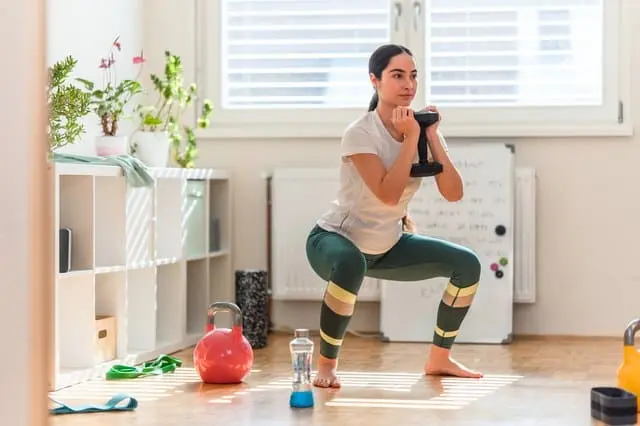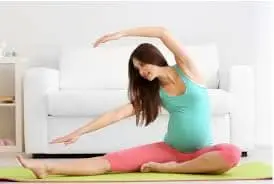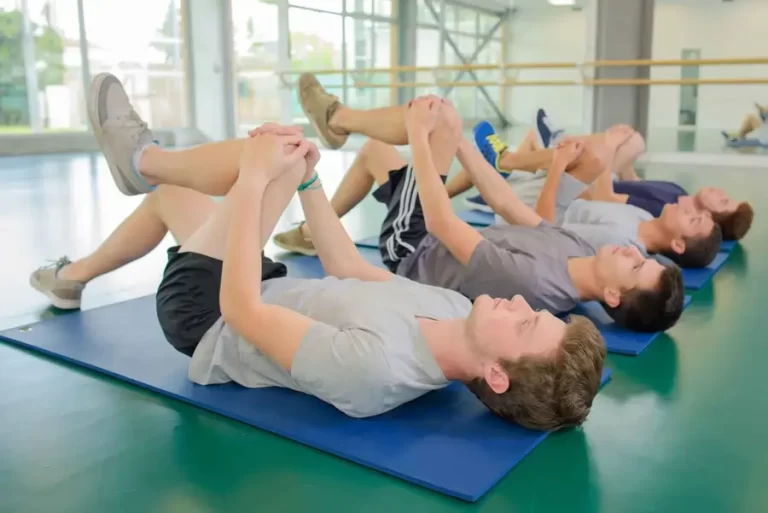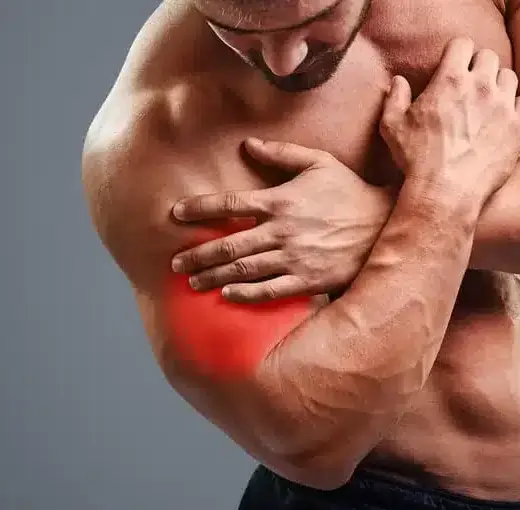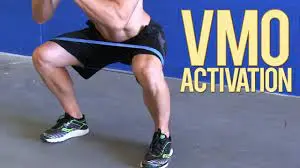20 Best Workouts for Inner Thighs
Welcome to the world of fitness, where you can achieve the goal of having toned, muscular inner thighs. Your body’s ability to stabilize and support itself greatly depends on the adductor muscles located in your inner thighs. You can improve your strength and appearance by creating a well-rounded workout routine that works these muscles.
We’ll look at good Workouts for Inner Thighs in this article that combines focused movements, good form, and progressive development.
What is an Inner Thigh?
The inner thigh is the area of your legs that contacts when your feet are squeezed together. The inner thigh is the region inside your leg that starts at the pelvic bone and ends just above the knee. Even though the inner thighs are not usually the center of attention during a workout, they are an important part of the leg to work on to build muscle.
Furthermore, they are necessary for easy everyday mobility.
What Muscles Are in the Inner Thigh?
The inner thighs are composed of five different types of hip muscle groups: the gracilis, pectineus, adductor brevis, adductor longus, and adductor magnus. They extend up to the thigh bone from the pelvic region.
- Gracilis
This muscle contracts to flex the leg at the knee and adduct the thigh at the hip. It is necessary to bend and twist.
- Pectineus
A minor muscle located in the inner thigh that facilitates hip flexion and adduction.
Hip flexion and adduction are helped by this muscle, which is situated under the adductor longus.
- Adductor Longus
This big, flat triangle muscle that adducts the thigh partially covers the adductor brevis and Magnus. It also comprises the most anteriorly located adductor muscle.
Situated in the medial section, this muscle is the largest of the inner thighs. Its shape is a fan. Together with the hamstrings, it adducts the thigh to produce hip flexion.
The benefits of Inner Thigh Workout:
- Having strong inner thighs makes it easier to keep other body parts stable and reduces your risk of injury.
- Workouts for the Inner Thighs focus on the adductor muscles, helping in their tone and strength. This could lead to improved muscle definition and flexibility in the inner thigh area.
- Workouts for the inner thighs help stabilize your pelvis, improving your ability to run fast and change directions.
- Leg power can be improved by inner thigh workouts, particularly those that involve resistance or weight bearing. Powerful inner thigh muscles help to produce force and strength when doing actions like kicking and jumping.
- Age-related changes in muscles and bones can affect movement. Older persons can avoid falls by strengthening their inner thighs, which contributes to hip and knee stability and balance.
- Strong and well-conditioned inner thigh muscles are advantageous for athletes who play lateral movement sports like basketball, soccer, or skating. These routines can help with speed, flexibility, and overall athletic performance.
Workouts for Inner Thighs:
Training the inner thigh muscles can help increase the overall strength and stability of the lower body since they support the hips and core during a variety of motions.
Lateral lunges
- Begin in a comfortable standing position on the ground.
- Lean your left leg out to the side as you take a step forward.
- Both feet should be flat on the floor with all toes pointing in the same direction.
- As you step forward, maintain a straight back and flex your left knee.
- Your lower body should feel as though you are attempting to find comfort on a chair with only one side being supported.
- Hold this position for a few seconds.
- To get back to where you initially were, push off with your left foot.
- Then relax.
- Repeat this workout 5 to 10 times in a day.
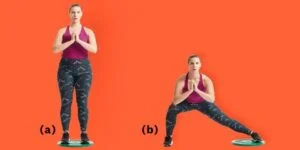
Seated hip adduction
- All you need to concentrate on is pressing your thighs together because the seated hip adduction separates the hip adductor muscles.
- Sit with your back resting on the machine’s backrest.
- To avoid overstretching your adductor muscles, adjust the length of the knee pad such that it gives your inner thighs a good stretch.
- Set up a lightweight for the first set so as not to go overboard.
- Breathe out, then press your thighs together until your knees meet in the center of your body.
- Hold this position for a few seconds.
- Then return to your neutral position.
- Then relax.
- Five to ten times through, repeat this workout.
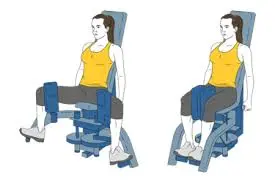
Cable Hip Adductions
- The pulley is closest to you when you choose an attachment that you can secure to your ankle.
- Get the ankle and calf to pulley at the same level.
- Put your body next to the pulley.
- Support yourself by pressing your hand against the machine in a safe spot where your fingers won’t hurt.
- Extend the leg that is being used the most, facing the pulley.
- Step the leg in the direction of your waist, away from the pulley.
- Then return to your neutral position.
- Then relax.
- Repeat this workout five to ten times.
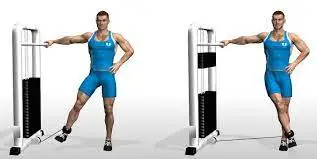
Sumo squat
- Keeping your feet wider than hip-width apart, take a toe step outward.
- Hold a dumbbell or kettlebell between your legs with both your left and right hands if you’re utilizing weights.
- Pull your knees out and bend them in until your thighs are parallel to the floor.
- As a result, you will be able to drop to the ground gradually.
- Maintaining your weight in the middle, tap your knees repeatedly without releasing them as you bend them.
- Hold this position for a few seconds.
- Then slowly raise yourself back up, expand your glutes, tighten your inner thighs, keep your spine neutral, and straighten your knees.
- Then relax.
- Repeat this workout five to ten times.
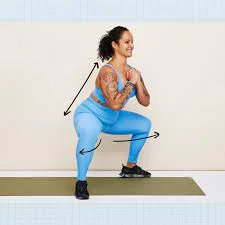
Side-Lying Hip Adduction
- Lay on your left side on the mat or the floor with straight legs.
- Cross your right leg over your left, keeping your right foot flat on the floor and your right knee pointing toward the ceiling.
- Place your left hand beneath your head and your right hand on the ground in front of you.
- Raise your left leg toward the ceiling while keeping your leg straight at all times.
- Gently lower the left leg back down after a short while.
- Then return to your neutral position.
- Then relax.
- Repeat this workout five to ten times.

Skater
- Make sure to have your abs tight, your feet together, and your knees slightly bent.
- Push off with your right leg and leap to the left, allowing yourself to leave the ground.
- Bending forward at the hips, perform a small curtsy lunge by lifting your right leg slightly behind while landing on your left leg.
- To finish the first complete repetition, go back to the right side for a brief moment.
- Then return to your neutral position.
- Then relax.
- Repeat this workout five to ten times.
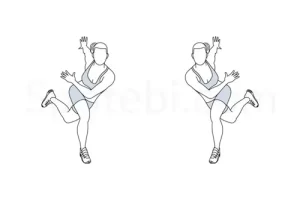
Single leg circle
- Arms at your sides, palms down, as you lie down.
- Extend your left leg along the mat and your right leg up toward the ceiling.
- Take a breath to get ready.
- Breathe out and move your right leg in a circle away from your midline, keeping it extended.
- To finish the circle, inhale as you circle the leg inward.
- Draw a circle and circle it five times in a clockwise direction and five times counterclockwise.
- Then return to your neutral position.
- Then relax.
- Repeat this workout five to ten times.

Criss Cross Flutter Kicks
- Lie flat on your back and place your arms under your head.
- Straightening and elevating your legs off the floor is better.
- Stretch your legs across the floor, putting one foot on top of the other, and then bring them back together.
- Stretch your legs apart once you’ve brought them together, then alternate which foot is on top.
- Then return to your neutral position.
- Then relax.
- Repeat this workout five to ten times.
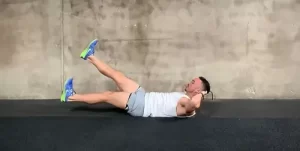
Pile squat
- When standing, place your feet wider apart than shoulder-width apart.
- Place your feet at an angle of 45 to 90 degrees so that they face the same direction as your knees.
- Sit comfortably with your knees slightly bent and your back upright.
- Tighten your abdominal muscles.
- Once you’re comfortable going no farther, squat down until your thighs are parallel to the floor.
- Maintain a straight posture for a few seconds more.
- Then return to your neutral position.
- Then relax.
- Repeat this workout five to ten times.
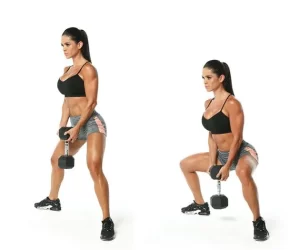
Glute bridge with prop squeeze
- On the ground, lie down.
- Place your feet firmly on the ground.
- Position the prop so that it sits between your legs.
- Release the tension in your hamstrings and glutes by raising your hips.
- Firmly press down on the prop so that it hits your inner thighs.
- Hold this position for a few seconds.
- Then return to your neutral position.
- Then relax.
- Repeat this workout five to ten times.
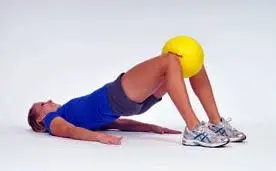
Lateral Squat Walk
- Apply a resistance band around your ankles or just above your knees, extending across your lower thighs.
- Maintain this position with your feet hip-width apart.
- Keep your spine tall and your chest upright while you push your bottom back and bend down.
- To maintain your squat position, make 10 gradual movements to the right while maintaining band tension.
- After you’ve reset, take ten steps to the left while you’re still squatting.
- Then return to your neutral position.
- Then relax.
- Repeat this workout five to ten times.
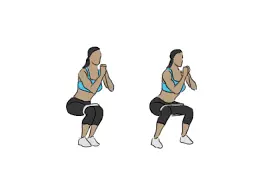
Scissor Legs Plank
- Begin in the push-up position, with your feet together, your body straight from your head to your heels, and your arms parallel to your shoulders but a little wider.
- This is where everything begins.
- Like you would in a horizontal jumping jack, extend your legs while maintaining your core engaged.
- Then return to the starting position without allowing your hips to drop.
- Then relax.
- Repeat this workout five to ten times.
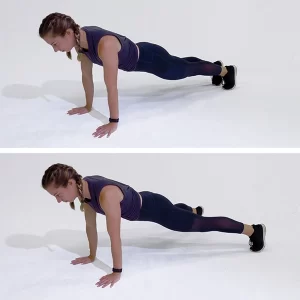
Single Deadlift
- Standing with your feet hip-distance apart, your knees should be slightly bent.
- When using weights, always keep your arm straight and the weight in your right hand at waist level.
- Lean forward from the waist and extend your left leg past your body while keeping your hips in alignment.
- Bend only until the weight touches the floor or until your hips start to rotate.
- Get back into an upright posture, maintaining a neutral spine and shoulders away from your ears.
- Hold this position for a few seconds.
- Lift yourself to the beginning position, allowing the toes of the left foot to move across the floor.
- Then relax.
- Repeat this workout five to ten times.

Step up
- When standing, keep your back straight and your trunk upright.
- When using weights, place dumbbells at your sides and hold one in each hand, or place one in the center of your chest and hold it with both hands.
- Gently lift your left foot and plant it firmly on the box or bench.
- Apply pressure through your left leg to your left heel to raise your entire body to a standing position on your left leg.
- Step back with your right foot and place both feet back on the ground.
- After that, lift your right foot and plant it firmly on the bench.
- You should then be able to stand straight on your right leg by applying pressure through it.
- Put your left foot down and lower yourself.
- Alternate legs during the workout until you reach the desired number of repetitions.
- Then relax.
- Repeat this workout five to ten times.

Clamshell
- When lying on your side, bend your knees to a 45-degree angle.
- To activate your core, pull the belly button in the direction of your spine.
- Maintaining your feet together, progressively raise your upper leg.
- Keep your hips from twisting.
- Hold this position for a few seconds.
- Then return to your neutral position.
- Then relax.
- Repeat this workout five to ten times.
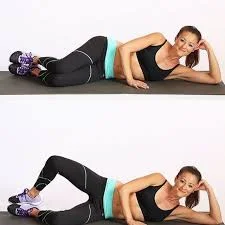
Curtsy Lunge
- Arrange your arms at your sides and maintain a shoulder-width distance between your feet.
- Step back and around with your left foot, almost like you’re curtsying, while shifting your weight into your right foot.
- This will allow your arms to comfortably come up in front of you.
- Make sure your chest remains firm.
- You should stop lunging when your right thigh is level to the floor.
- As you push through your heel to straighten your right leg, bring your left foot back to the beginning position.
- Then relax.
- Repeat this workout five to ten times.
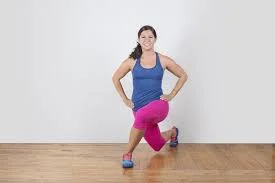
Jefferson Squat
- Use a barbell on the floor and select your desired weight.
- As you widen the position and hold the barbell horizontally, your rear hip and foot should rotate outward.
- Stretch your back foot outward to almost a 90-degree angle.
- Direct your upper body towards the leg that is facing forward.
- Your posture may need to change to lower yourself into a squat.
- As the barbell passes between your legs, place one flat foot on either side of the object.
- Your posture should be upright with your knees slightly bent and your feet shoulder-width apart.
- Shoulders should be positioned just above hips.
- Do not bend your elbows; instead, keep your arms straight.
- Make sure you are engaging your core.
- Drop to a squat and use a mixed grip to pick up the barbell.
- You should hold the barbell with your front hand in an underhand grip facing you and your backhand in an overhand grip behind you.
- Your legs should be straight and your chest elevated.
- Lift the barbell and stand up straight to begin the workout.
- Bending your hips, knees, and ankles is the first step towards lowering yourself into the bottom position.
- Keep your knees over your toes as you lower to the bottom of the squat.
- Lower yourself once your upper legs are parallel to the floor.
- Hold for a few in the lowest position.
- Start the upward movement by placing your feet firmly on the floor and extending your hips, knees, and ankles.
- Standing upright, keep your chest high, bend your knees, and push your hips forward, all while contracting your glutes.
- Then relax.
- Repeat this workout five to ten times.
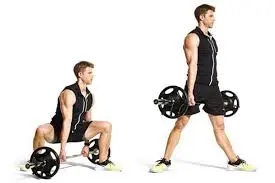
Bulgarian Splint Squat
- To begin, place yourself about two feet in front of a step or bench that is knee-level.
- Place your right foot on the bench with the top of your foot raised behind you.
- To ensure an easy lunge, position your right foot far enough in front of the bench.
- Adjust your feet.
- Your feet should still be approximately shoulder-width apart.
- If placing your feet closer together helps, just make sure that your left knee does not cross your toes as you lower.
- Lean slightly forward at the waist and pull your shoulders back while contracting your core.
- Then, start lowering your left leg and bending its knee.
- Hold this position for a few seconds.
- To get back up to standing, push through your left foot and use your hamstrings and quadriceps for strength.
- Then relax.
- Repeat this workout five to ten times.
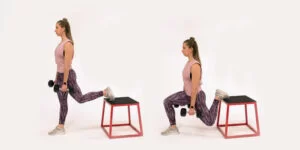
Reverse lunge
- Start with your arms by your sides, your feet standing hip-width apart, and a straight posture.
- Feel free to use a dumbbell or kettlebell for an added challenge.
- Step back with the right foot, keeping your core tight.
- With the right heel up and the right toes curled under for balance, bend both knees until the rear knee just barely touches the floor.
- To bring both feet back to the beginning position, push through them.
- Then relax.
- Repeat this workout five to ten times.

Cossack Squats
- Spread your toes slightly apart and stand with your feet wider than shoulder-width apart.
- Move your weight to that side and bend your knee to lower yourself into a lateral squat on that side.
- Hold the other leg straight and the foot flat on the floor with the toes directed upwards as you squat to the other side.
- Maintain a straight back and raised chest while lowering as far as is comfortable for you.
- Hold this position for a few seconds.
- Use the heel of the lowered leg to move yourself back to the starting position.
- Then relax.
- Repeat this workout five to ten times.

What safety precautions are required when working out?
- During your workouts, make sure to maintain a straight posture.
- Between workouts, give yourself a rest.
- When working out, stop if you get any sudden pain.
- Wearing loose, carefree attire that encourages movement and relaxation is ideal for working out. Don’t dress in fashionable or tight apparel.
- Every workout must be performed according to the protocol, which calls for warm-ups and cool-downs in addition to the correct amount of repetitions for each movement.
When do you not work out?
- Fever
- Headache
- You don’t feel good
- Severe pain in muscles
Summary:
Finally, general lower body strength, stability, and aesthetic goals can all benefit from efficient inner thigh training. You can achieve muscular tone and definition in the inner thigh region by including particular workouts such as leg lifts, squats, lunges, and lateral motions.
For optimal results in terms of inner thigh toning and overall fitness, a comprehensive program that includes cardiovascular workout, full-body strength training, and a balanced diet is recommended. Maintaining regularity is essential for tracking progress. Achieving your inner thigh goals requires gradually increasing the resistance and intensity of your workouts, keeping good form, and allowing your muscles enough time to recover.
In the end, while working out your inner thighs might help you achieve the right muscle tone, it’s still crucial to have an overall approach to fitness and prioritize your general health and well-being. Before beginning any new workout program, always get advice from a fitness expert or healthcare provider, particularly if you have any underlying medical issues or concerns.
FAQ:
Can I lose fat in specific areas of my inner thighs?
Reducing fat in one place at a time is usually ineffective. A balanced diet and frequent aerobic exercise are necessary for total fat loss to remove fat in any location, including the inner thighs.
Do squats affect the inner thighs?
By mastering the barbell back squat, you may increase your physical condition and gain great strength in your lower body. By adding it into a sumo squat, you may efficiently target the adductors and inner thighs.
Do inner thighs benefit from walking?
Fantastic for burning calories and reducing body fat overall, including inner thigh fat, walking is an excellent cardiovascular activity. To exactly target inner thigh fat, walking alone might not be sufficient, it is vital to highlight.
How can inner thighs be toned the best?
Curtsy Lunge
Sumo Squats
Lateral Lunges
Scissor Legs Plank
Criss Cross Flutter Kicks
Clamshell
What advantages come with having strong inner thighs?
Strong inner thighs support stability, movement, and injury prevention. All you’ll need is your body weight and the area of a workout mat.
Why do workouts for the inner thighs?
Legs can be shaped and muscled up using workouts that target your inner thighs. To help you, the muscles in your inner thighs must be powerful. Keep your balance. Adjust your legs and hips.
How does the inner thigh work?
The muscles in your inner thighs called the adductors, are essential for maintaining your balance, stability, and safety while you move. Your hips, knees, low back, and core all need to be stabilized, therefore they’re really important.
References:
- H. Sutariya (2023, Dec. 13). 20 Greatest Inner Thigh Exercises – Mobile Physio. Mobile Clinic for Physiotherapy. The 20 best exercises for inner thighs are available at https://mobilephysiotherapyclinic.in.
- On June 9, 2024, Anderson, A. How to Perform Inner Thigh Exercises. Web Medical. How to Perform Inner Thigh Exercises: https://www.webmd.com/fitness-exercise
- July 25, 2023b, Patel, D. Tones and strengthens your inner thighs with these 40 exercises. Samarpan Clinic for Physiotherapy. The top 40 exercises for inner thighs are available at https://samarpanphysioclinic.com.
- Nied, J., and A. Breitowich (2024, June 27). A Trainer Shares 16 Inner-Thigh Exercises You Can Do During Your Leg Day Workout. The Health of Women. Exercise for the inner thighs: https://www.womenshealthmag.com/fitness/g25996674
- On July 8, 2024, Smith, J., and Nasm-Cpt, K. G. Which Inner-Thigh Exercises Are Good for Targeting Those Hard-to-Target Adductors? The best inner thigh physical activity ever discovered at https://www.shape.com/fitness/workouts
- Image 6, Daisy. (10 June, 2021). Skaters | Detailed Workout Instructions. Skaters exercise guide by SPOTEBI. https://www.spotebi.com/
- Image 10, Knee squeeze and mini ball bridge with Thera-Band (n.d.) Performance Health Academy. Thera band mini-ball bridge with knee squeeze: https://www.performancehealthacademy.com/
- Image 11, GoFitnessPlan. (n.d.): Squat lateral walk. Squat-lateral-walk exercise from GoFitnessPlan: https://www.gofitnessplan.com
- Image 12, (2024, January 23). Millard, E. BODi: How to Perform the Plank Jack. The plank-jack exercise is available at https://www.beachbodyondemand.com.
- Image 16, Daisy. [5 June, 2021a]. Exercise Guide with Illustrations for Curtsy Lunge. The Curtsy Lunge exercise is available on SPOTEBI.
- Image 17, M, Y. (5 July 2021). Comment utiliser le Jefferson squat pour mettre du feu à ses quads et fessiers? Space Muscle. Jefferson Squat information on https://www.espace-musculation.com
- Image 20, (2013, November 18) FitnessFAQs. Tutorial & Progressions for the Cossack Squat Mobility Exercise [Video]. YouTube. YouTube: https://www.youtube.com/watch?v=tpczTeSkHz0

